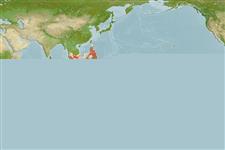>
Eupercaria/misc (Various families in series Eupercaria) >
Labridae (Wrasses) > Cheilininae
Etymology: Cirrhilabrus: Latin, cirrus = curl fringe + Greek, labros = furious (Ref. 45335); flavidorsalis: From the bright yellow outer half of the dorsal fin of the male..
More on authors: Randall & Carpenter.
Environment: milieu / climate zone / depth range / distribution range
Ecología
marino asociado a arrecife; rango de profundidad 6 - 40 m (Ref. 26153), usually 6 - 28 m (Ref. 37816). Tropical
Distribución
Países | Áreas FAO | Ecosistemas | Ocurrencias, apariciones | Point map | Introducciones | Faunafri
Western Central Pacific: Eastern Indonesia (northeast Kalimantan and Bali to West Papua), Malaysia (Sabah), and Philippines.
Tamaño / Peso / Age
Maturity: Lm ? range ? - ? cm
Max length : 6.5 cm TL macho / no sexado; (Ref. 48636)
Short description
Claves de identificación | Morfología | Morfometría
Espinas dorsales (total) : 11; Radios blandos dorsales (total) : 9; Espinas anales: 3; Radios blandos anales: 9. Males highly variable in color with dorsal fin colors from all yellow to red or blue, and body from red to pink or white, depending on mood and stage (Ref. 48636).
Inhabits finely branching corals on protected coral and rubble slopes. Occurs in aggregations (Ref. 37816).
Life cycle and mating behavior
Maturities | Reproducción | Spawnings | Egg(s) | Fecundities | Larva
Distinct pairing during breeding (Ref. 205).
Randall, J.E. and K.E. Carpenter, 1980. Three new labrid fishes of the genus Cirrhilabrus from the Philippines. Rev. Fr. Aquariol. 7(1):17-26. (Ref. 26153)
IUCN Red List Status (Ref. 130435)
Threat to humans
Harmless
Human uses
Herramientas
Special reports
Download XML
Fuentes de Internet
Estimates based on models
Preferred temperature (Ref.
123201): 28 - 29, mean 28.6 °C (based on 192 cells).
Phylogenetic diversity index (Ref.
82804): PD
50 = 0.5000 [Uniqueness, from 0.5 = low to 2.0 = high].
Bayesian length-weight: a=0.01585 (0.00707 - 0.03555), b=2.95 (2.76 - 3.14), in cm total length, based on LWR estimates for this (Sub)family-body shape (Ref.
93245).
Nivel trófico (Ref.
69278): 3.3 ±0.4 se; based on size and trophs of closest relatives
Resiliencia (Ref.
120179): Alto, población duplicada en un tiempo mínimo inferior a 15 meses (Preliminary K or Fecundity.).
Fishing Vulnerability (Ref.
59153): Low vulnerability (10 of 100).
Nutrients (Ref.
124155): Calcium = 161 [93, 356] mg/100g; Iron = 1.17 [0.64, 2.29] mg/100g; Protein = 18.2 [15.2, 20.4] %; Omega3 = 0.181 [0.096, 0.330] g/100g; Selenium = 24.2 [12.2, 50.0] μg/100g; VitaminA = 253 [76, 954] μg/100g; Zinc = 2.22 [1.40, 3.54] mg/100g (wet weight);
